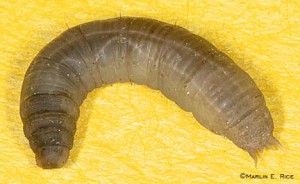I am amazed at the extent of damage in both winter cereal crops and grassland from leatherjackets already this season. Leatherjackets are the larvae of the crane fly or ‘daddy long legs’ and cause widespread damage to cereals, grassland, root crops and vegetables. Eggs are laid in the early autumn, and the larvae hatch and feed over the winter period.
Leatherjacket numbers are much higher this spring than they have been for many years. Where fields are looking poor or yellow, or bare patches have appeared, it is essential to inspect for leatherjackets. Damage is already becoming apparent in some established grass swards. With this evidence of high leatherjacket populations, spring cereals are also certain to be at risk, especially those following a grass ley. As crops are most susceptible to damage at the seedling stage it is most important to monitor leatherjacket numbers from emergence onwards.
In newly sown cereals the need for treatment is assessed by scratching along 30cm (12“) drill lengths to a depth of 5cm and searching for leatherjackets. The following grub numbers are the threshhold figures at which damage is likely to occur: -permanent pasture-100/m2 -spring cereals -50/m2 Young cereals are attacked both below and above the ground. To limit damage leatherjackets need to be detected before they have had a chance to do serious damage to your crops. A good early indicator of high populations is the presence of birds, in particular rooks, crows and starlings, in fields as they search for the grubs. Symptoms of leatherjacket damage are yellow dead plants or withered patches of grass that have been cut off from their roots just below the ground. On closer examination leatherjackets can be found by digging in the top 2-3 cm of the soil. At this time of year they are typically 1-2 cm in length grey in colour with a tough leathery coat, hence their name, and resemble a large maggot.
If numbers meet the threshold, chemical treatment should be applied using a product containing chlorpyrifos such as DURSBAN WG or CYREN. As the leatherjackets live in the soil the spray must reach the soil therefore a high water volume (500l/ha) is essential and a coarse spray quality to ensure good penetration into the soil surface. Light rain after the spray application will also help.
DursbanWG at 1.0kg per hectare gives the highest level of control of leatherjackets as it is strongly absorbed onto the clay particles in soil persisting for up to 6-8 weeks. Dursban’s unique formulation is based on a novel free-flowing granule containing 75% chlorpyrifos – the most concentrated active ingredient loading of any chlorpyrifos product. It is important to note when using an induction hopper a continuous flow of water through the hopper must be maintained. The sprayer should be half full before adding Dursban to the tank. When using a filter basket this must be removed and the Dursban WG added to the tank in a steady even flow maintaining agitation.
Chlorpyrifos is judged to be non injurious to birds and, at dose rates likely to result from commercial applications, little or no effect has been detected on overall populations of soil fungi, bacteria or algae.Dursban has also been shown to have little effect on earthworms and other beneficial arthropods.

